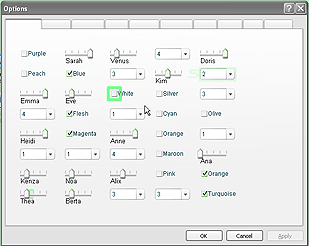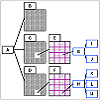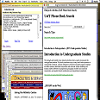| Welcome to
Shen's Home Page! |
Hi, my name is Shengdong
Zhao [Shen]. I am a fourth year Computer Science Ph.D. student at University
of Toronto. My supervisor is Prof.
Mark Chignell from MIE's Interactive Media Lab. My master degree is from
School of Information
Management & Systems, University
of California at Berkeley. My undergraduate program dual majored
in Computer Science and Biology at Linfield
College, Oregon.
During the summer of 2006, I interned under Ken Hinckley at Microsoft
Research (MSR), Redmond on a pen-based in situ search tool called InkSeine. The research result was submitted to ACM CHI 2007.
During the summer of 2005, I interned under
Maneesh Agrawala and
Ken Hinckley at Microsoft
Research (MSR), Redmond on gesture-based menu techniques. The research result
was published at ACM CHI 2006.
My past working experience includes working as a computer system
engineer at Lawrence
Berkeley National Lab, as a staff engineer at SeeUthere.com, Sillicon
Valley, and as an intern at Space Machine Inc.
At University of California, Berkeley, I worked as a Graduate
Student Researcher for Professor
Robert Wilensky on Multivalent
Document of the Digital
Library Project. Before joining UofT, I had worked one year as a
research associate for Prof. monica schraefel (now at University of Southampton,
U.K.).
My research field
is HCI (Human Computer Interaction). In general, I am interested in anything
related to HCI. In particular, my interests include gesture input, interaction
techniques, auditory interface, audio widgets, and information visualization.
Currently, I am working on:
- Auditory widgets and interfaces for mobile environment
- Gesture and pen-based interaction; gesture-based menus
- Information visualization
Here is my cv.
No teaching is planned for this year.
| December 27th, 2006 to January 25th, 2007 |
Visit my family and friends in Shanghai, China.
|
| April
28th to May 3rd, 2007 |
CHI 2007, San Jose, USA.
|
|
Publications
(in reverse chronological order)
|
Refereed (Full) Conference Papers:
 |
|
5. |
|
- Patrick Baudisch., Desney Tan, Collomb, M., Daniel Robbins,
Ken Hinckley, Maneesh Agrawala, Shengdong Zhao, and Gonzalo Ramos
(2006). Phosphor:
Explaining Transitions in the User Interface Using Afterglow Effects. Proceedings of UIST 2006 - the ACM Symposium
on User Interface Software and Technology. p. 169-178.
- Summary: Sometimes users fail to notice a change that just took
place on their display. Animated transitions can help, but they force
users to wait for the animation to complete. We
propose a different approach. Phosphor objects show the
outcome of their transition instantly; at the same time they explain
their change in retrospect. We present a framework of transition
designs for widgets, icons, and objects in drawing programs. We
evaluate phosphor objects in two user studies and report significant
performance benefits for phosphor objects.
|

|
|
4.
|
|
- Shengdong Zhao, Maneesh Agrawala, Ken Hinckley (2006). Zone
and polygon menus: using relative position to increase the breadth of
multi-stroke marking menus. Proceedings of CHI 2006 – the ACM Conference on
Human Factors in Computing Systems (CHI) 2006. pages 1077-1086. [Acceptance
rate: 118/506 or 23%]
- Summary: Zone and Polygon menus are two new variants of multi-stroke
marking menus that consider both the relative position and orientation
of strokes. Our menus are designed to increase menu breadth over
the 8 item limit of status quo orientation-based marking menus.
We also discuss hybrid techniques that may further increase menu
breadth and performance.
- movie (22 MB wma, 720x480, 29.970 fps,
5:02)
- PPT slides
of my talk at CHI 2006.
|

|
|
3.
|
|
- Shengdong Zhao, Michael J. McGuffin, Mark H. Chignell (2005). Elastic
hierarchies: combining treemaps and node-link diagrams. Proceedings
of IEEE Symposium on Information Visualization (InfoVis) 2005.
pages 57-64. [Acceptance rate: 31/114 or 27%]
- Summary: considers hybrid graphical representations that combine
node-link and treemap diagrams for the purposes of tree visualization.
The concept of elastic representational space is introduced. A theoretical
analysis yields a taxonomy of various potential hybrid combinations,
and a prototype system is implemented to experiment with these.
- movie
(28 MB avi, DivX 6.0 encoded, 720x480, 29.970 fps, 5:00)
Although the prototype does support some animated transitions, performance
problems during the capturing of the video resulted in these animations
not being very apparent in the video.
- PPT slides of my talk at InfoVis
(text transcript of the talk included in the note section of each
slide).
- DGP IRG talk slides on an overview
of Tree and Treemap visualizations (2003).
- Reference entry.
|

|
|
2.
|
|
- Shengdong Zhao, Ravin Balakrishnan. (2004). Simple
vs. compound mark hierarchical marking menus. Proceedings of
UIST 2004 – the ACM Symposium
on User Interface Software and Technology. p. 33-42. [Acceptance
rate: 36/170 or 21%. Received 5,5,5,5 from all reviewers - the
highest review score in UIST 2004.]
- Summary: simple mark techique (multi-stroke marking menu) is a
variant of hierarchical marking menus where items are selected using
a series of straight lines, rather than the single "zig-zag"
compound mark used in the traditional design. Study shows multi-stroke
marking menu increase menu depth, and is faster and more accurate
than the traditional compound mark technique while requiring less
input space. Before this paper, a single continuous stroke is generally
regarded as a better way to perform gestures, but our paper shows
that by breaking a complex continuous stroke into simple segments,
the performance could be improved.
- PPT slides
of my talk at UIST, please also download the WMA
file for a short video inside of the PPT file. And, I recorded
the audio for the UIST presentation
- Reference entry.
-
|

|
|
1.
|
|
- monica schraefel, Yuxiang Zhu, David Modjeska, Daniel Wigdor, Shengdong
Zhao. (2002) Hunter
gatherer: interaction support for the creation and management of within-web
page collections. Proceedings of the eleventh international conference
on World Wide Web. p. 172-181.
- Summary: Hunter Gatherer is an interface that lets Web users carry
out three main tasks: (1) collect components from within Web pages;
(2) represent those components in a collection; (3) edit those component
collections. Our research shows that while the practice of making
collections of content from within Web pages is common, it is not
frequent, due in large part to poor interaction support in existing
tools. We engaged with users in task analysis as well as iterative
design reviews in order to understand the interaction issues that
are part of within-Web-page collection making and to design an interaction
that would support that process.
- Reference entry.
|
Short Papers, Workshop Papers, Posters:
|
|
4.
|
OCT2
- OCT2
is a new and improved version of the original OCT system (software to
manage the conference paper submission and reviewing process) deveveloped
by David Gering. OCT2 was used for the CVPR 2003 paper submission and
review process and was co-developed by Shengdong
Zhao and Kyros Kutulakos.
(application)
|
|
|
3.
|
DInfoBuilder: (Dynamic Information Builder)
- DInfoBuilder builds the next generation information management software.
It enables efficient, simple development, maintenance, and transformation
of information systems. DInfoBuilder allows non-technical personnel
to quickly build a dynamic e-commerce application on the web and wireless
platforms. The resulting applications will be platform independent,
device independent, database independent. DInfoBuilder will greatly
improve the ways information are organized, presented, interoperated,
and interacted. (SIMS
master project)
|
|
|
2.
|
Multivalent Browser:
I built the first version of PDF media adapter by porting xPDF's code
to Java.
This project has evolved to an open source software application. (code
library)
|
|
|
1.
|
DOE2000 Electronic Notebook:
I worked as a computer system engineer in Lawrence Berkeley National Lab
with
Dr. Sonia Sachs on this project for one year. (application)
|
Shen's Blog
Place to find useful word
templates (include templates for CV and thesis).




